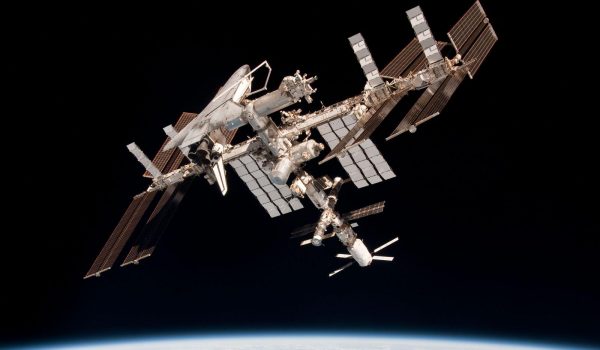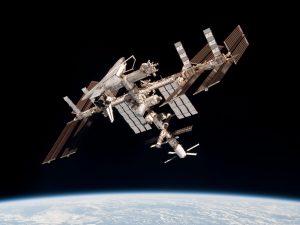

This image of the International Space Station with the docked ATV Johannes Kepler and Space Shuttle Endeavour was taken by Expedition 27 crew member Paolo Nespoli from the Soyuz TMA-20 following its undocking on 24 May 2011 (Credits: ESA).
The International Space Station (ISS) crew was alerted of a possible collision with a left over piece of an old Russian satellite on March 24, forcing them to take emergency shelter in the two docked Soyuz capsules. The debris passed 11-14 km from the station, a very near miss in space debris terms.
According to NASA officials, “The piece of space junk was spotted too late to move the orbiting laboratory out of the way and flew as close as 11 kilometers when it zoomed by at about 2:38 a.m. EDT (0638 GMT)”
This debris was a product of a previous crash between Iridium 33 and Cosmos 2251 in 2009. This crash produced over 2,000 pieces of debris that now orbit Earth. Usually this kind of space debris is detected in time to take evasive actions, but this one was detected too late. “This was a very erratic piece of Cosmos 2251 debris and tracking it was very difficult,” NASA spokesman Michael Curie wrote in an email to Reuters.
Although the chances of collision were minimal, Mission Control decided it was a potential danger, and ordered the ISS crew, including three Russian cosmonauts, two American astronauts and a Dutch astronaut, to take shelter in the docked Soyuz capsule for additional protection encase the station were to depressurize.
Flight director Jerry Jason told station commander Dan Burbank and the crew “We’re not too concerned about it, but it’s too late to do a debris avoidance maneuver.” It takes 24 hours for ISS to take evasive action in response to a debris alert. This lag is due to the time it takes for first the US to detect a potential collision, then Russia to design an appropriate propulsive response and execute it.
This is the third time in 12 years that ISS crew took shelter because of a possible impact with space debris.
Don Pettit, American astronaut on the ISS told Mission Control on Friday, “I’m hoping to try snap a photo of the space debris” but the object passed over the space station without being seen, and one of the astronauts said in Russian “I don’t see nothing, which is good news,” as translated in a NASA broadcast.
During a NASA TV commentary of the space debris flyby, NASA spokesman Bob Navias referred to the space debris as “relatively small” although the size was not precisely determined.
Space debris is increasing as is the threat it poses to the astronauts and cosmonauts on the ISS. There are about 6,000 tons of space debris in orbit today. NASA and the U.S military’s Space Surveillance Network track over 20,000 space debris objects to help prevent additional collisions creating more debris and damaging spacecraft.
Below Mission Control monitors the situation as the debris passes ISS:

















































































































![A trajectory analysis that used a computational fluid dynamics approach to determine the likely position and velocity histories of the foam (Credits: NASA Ref [1] p61).](https://www.spacesafetymagazine.com/wp-content/uploads/2014/05/fluid-dynamics-trajectory-analysis-50x50.jpg)



Leave a Reply